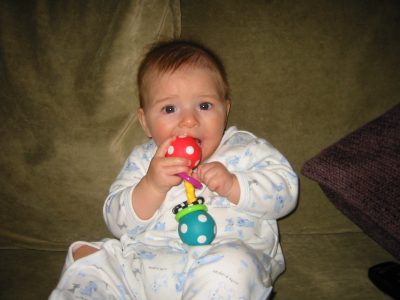Edited by: Ali Cooper, OT Reg. (Ont) & Lizette Alexander, OT Reg. (Ont) with appreciation for our student’s hard work.
When babies are born, their first inclination is to follow their reflexes. The rooting and suckling reflexes, for example, ensure the baby is getting the nourishment they need to survive and grow (Kotagal, 2019). With practice, suckling becomes a skill that most babies can manage very well. The grasp reflex works similarly, allowing babies to reflexively grab objects  placed into their hands much sooner than learning to purposefully reach and grasp for objects (Kotagal, 2019). While reflexes serve other functions as well, we know that as reflexes disappear, babies start to learn specific and more purposeful movements and skills to interact with and explore their environment to engage in activities.
placed into their hands much sooner than learning to purposefully reach and grasp for objects (Kotagal, 2019). While reflexes serve other functions as well, we know that as reflexes disappear, babies start to learn specific and more purposeful movements and skills to interact with and explore their environment to engage in activities.
How Do Infants Gain These Skills?
As adults, when we think about the way that we learn a new motor skill, it’s pretty intuitive to us: we find information related to that skill, practice it, and continuously refine it before we can begin to master it (i.e., feedback, trial-and-error). With babies and infants, it may not be as intuitive. We may come to think that babies learn to do things on their own simply as they grow and experience different opportunities here and there. While part of this is true, there is actually a tremendous amount of potential and room for growth that caregivers can explore and take advantage of when supporting their child’s development.
Infants go through a rapid period of motor, cognitive, sensory, and emotional development in their first year, all while interacting with their environments and engaging in activities (Center for Disease Control and Prevention, 2020). One of the most important changes at this time is the development of their motor skills and the introduction of solid foods. These skills are acquired through motor learning and practice (check out last week’s post to learn more about Motor Learning!). From around 6 months to 12 months, babies typically go from being stuck on their backs or bellies to reaching, rolling, sitting unassisted, crawling, standing, cruising, and eventually walking (Children’s Minnesota, 2020)! The introduction of solid foods also occurs around the 6-month mark, when babies are progressively able to develop their gross motor and fine motor skills (Children’s Minnesota, 2020). Feeding comes with a host of behavioural and sensory implications, and there are practical tools that caregivers can implement to make this a positive and healthy experience.
How soon and how well babies master skills in the first year and beyond depends a great deal on the amount of opportunity and support they receive. As caregivers, our role is to provide those opportunities for learning, and have fun along the way. With that, however, also comes the importance of avoiding certain positions and monitoring the child’s development to watch for red flags or significant delays.
Key Factors in Supporting Milestones
- Rich Sensory Environments allow a child to use their different senses (i.e., touch, sight, sound, taste, smell).
- Developmentally Appropriate Toys ensure a child can use the toys based on their current level to practice new skills.
- Opportunity to Explore Their World. Without opportunity, a child can’t practice.
- Proper Positioning.
On the other hand, caregivers may unknowingly prevent their child from reaching their optimal developmental potential by not providing them with opportunities to master important skills. This could be from frequent improper positioning, for example, or from lack of opportunity to practice newly acquired motor skills by being contained in baby equipment’.
The Role of Occupational Therapy (OT) in Infant Development
OTs, who are regulated healthcare professionals focused on enabling occupation and engagement, are perfectly positioned to support infants and caregivers in this area. When working with infants, OTs focus on evidence-based and practical approaches to support the development of important skills, allowing infants to interact with the world around them. They can coach parents to implement fun and engaging activities that will specifically target their child’s developmental age and lead toward optimal growth, and also help educate on what to avoid and identify potential red flags along the way.
How TCTC Can Help
The development occurring in that first year of a baby’s life is so important and sets the stage for much of their growth in the early years. TCTC is partnering with registered OT, Ali Cooper, to launch a new online program: Sprouting Seedlings: an OT-based approach to infant development. This program can help caregivers support their child’s development from 6 to 12 months through an occupational therapy perspective. It will address motor milestones, such as the ones described above, as well as discuss the complexities of feeding and co-regulation. Being a new caregiver comes with a host of questions and a desire for connection. This program serves as a community; a safe and open space for caregivers to develop a deeper understanding of the exciting and profound changes that their child will go through in the coming months. If you believe you and your child could benefit from this program, click the link above to sign up!
References
Center for Disease Control and Prevention (2020). Positive parenting tips: Infants (0-1 year of age). CDC: U.S. Department of Health & Human Services. Retrieved from: https://www.cdc.gov/ncbddd/childdevelopment/positiveparenting/infants.html
Children’s Minnesota (2020). Developmental milestones 6 to 12 months. Children’s Hospitals and Clinics of Minnesota. Retrievd from: https://www.childrensmn.org/educationmaterials/childrensmn/article/15314/developmental-milestones-6-to-12-months-/
Kotagal, S. (2019). Neurologic examination of the newborn. In. M. S. Kim (Ed.), UpToDate. Retrieved April 29, 2020. Doi: https://www.uptodate.com/contents/neurologic-examination-of-the-newborn
